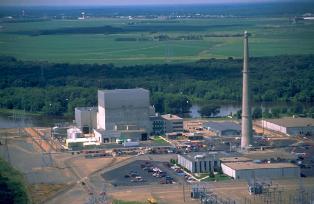beam supporting a large control box dropped from its mountings.
 Monticello, owned by Xcel Energy and operated by Nuclear Management Company (NMC), is a boiling water reactor (BWR) built in 1967 by General Electric and Bechtel. It outputs 613 MWe to the grid and has a strong operating record, receiving awards from General Electric and Minnesota Safety Council over its 36 years of commercial operation. In November 2006, its licence to operate was extended by the Nuclear Regulatory Commission (NRC) until September 2030.
Monticello, owned by Xcel Energy and operated by Nuclear Management Company (NMC), is a boiling water reactor (BWR) built in 1967 by General Electric and Bechtel. It outputs 613 MWe to the grid and has a strong operating record, receiving awards from General Electric and Minnesota Safety Council over its 36 years of commercial operation. In November 2006, its licence to operate was extended by the Nuclear Regulatory Commission (NRC) until September 2030. However, on 11 January an I-beam supporting the turbine control valve enclosure in the plant's turbine hall broke loose from the building's overall structure. One side of the enclosure support dropped 15-20 cm onto a large steam pipe.
Kelli Huxford, NMC's Communications Manager for the Monticello site, told WNN on 17 January that steam pipe integrity was maintained and no steam escaped, but the extent of the damage to the pipe and other nearby structures was not yet known as the enclosure, which reportedly weighs over 15 t, had not yet been fully lifted. A 23 January release from NMC confirmed that steam lines suffered no damage.
Radiological conditions at BWRs do not permit access to the turbine hall during power generation and so no plant personnel were in the vicinity of the valve enclosure when it dropped.
Safety systems at the plant promptly shut it down as turbine control mechanisms in the enclosure malfunctioned, opening main steam isolation valves that caused steam pressure to drop, which activated sensors and triggered a full shutdown. Jan Strasma of the NRC said that all the plant's safety systems functioned normally and there was no release of radioactivity or threat to public health and safety.
Strasma added that "the initial assessment is that the welds broke due to vibration over the years," but this was denied by Huxford who told WNN that plant engineers' were currently examining a number of theories. Huxford said that among the theories under consideration are that the welds fixing the supporting I-beams to the overall building structure were underdesigned, and that the supporting strucutre as a whole may have been underdesigned.
According to NMC's 23 January statement, its root cause investigation found that the "control box support structure design was inadequate and that, when installed, some welds were undersized or lacked quality." Plant personnel evaluated similar structures in both the turbine and reactor buildings and identified no additional areas of concern.
The control box support structure has been modified and strengthened while other affected equipment in the vicinity was repaired and tested.
The plant was restarted on 23 January and was expected to reach full power "within a few days."
Further information
Nuclear Management Company
Nuclear Regulatory Commission
Xcel Energy




_53514_33880.jpg)


_91467.jpg)





